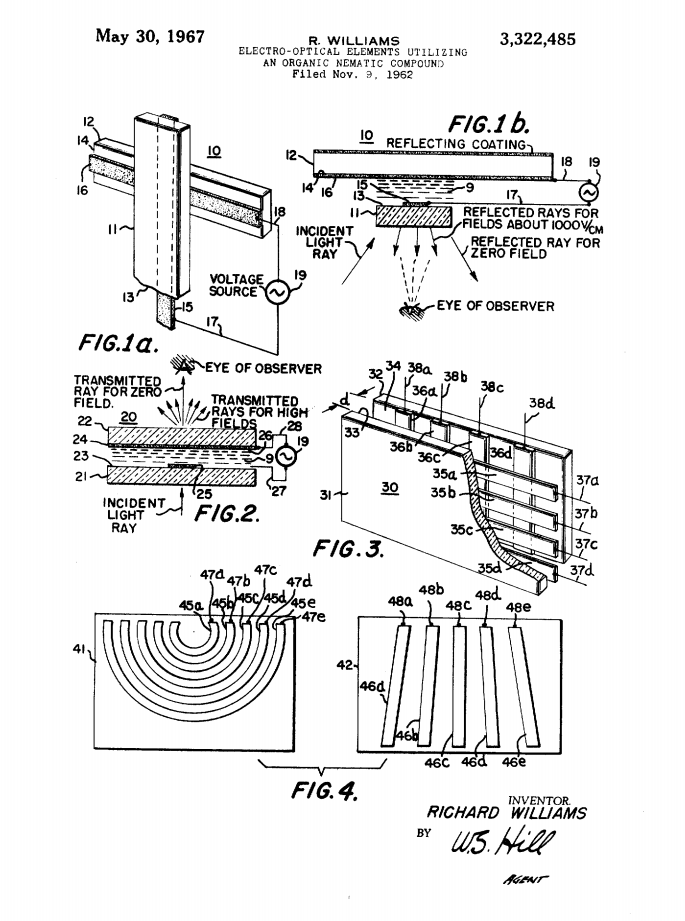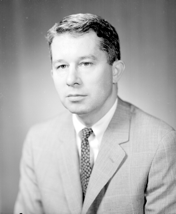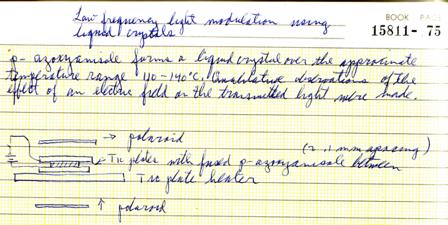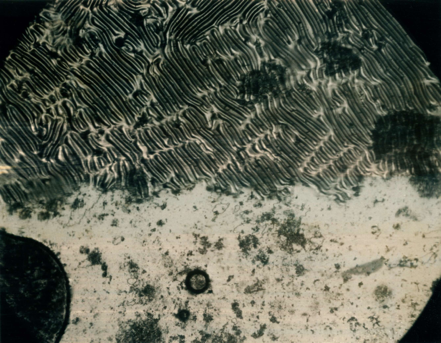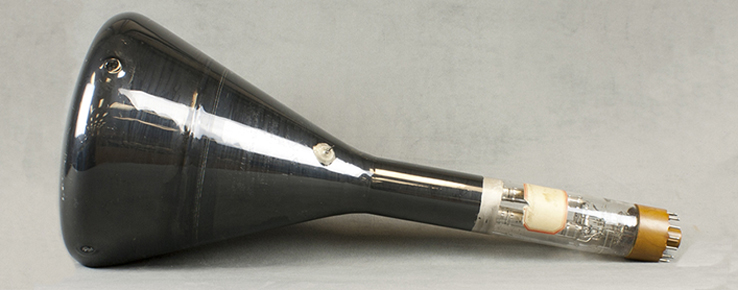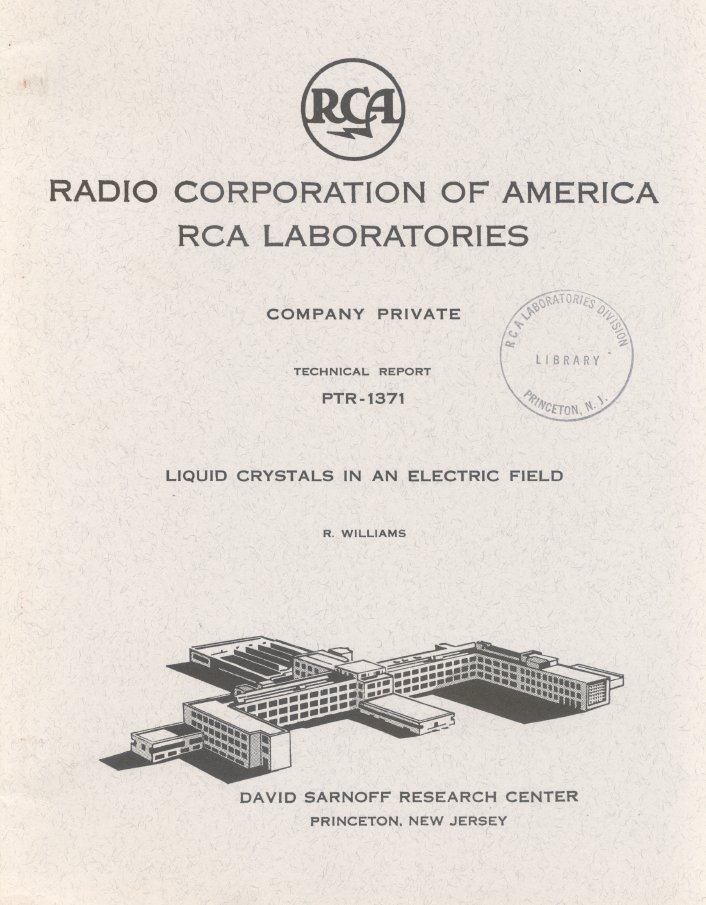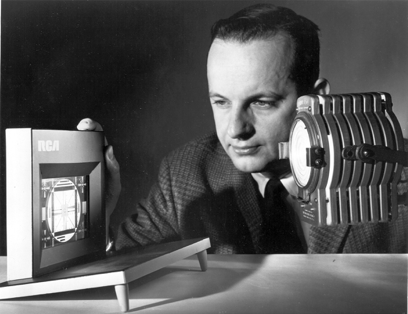#OnThisDay in 1967, Richard Williams received a patent for "Electro-Optical Elements Utilizing an Organic Nematic Compound." It was RCA& #39;s first liquid crystal display patent & the only one issued before the company went public w/the #LCD in 1968.
#histSTM #electronics
(1/20)
#histSTM #electronics
(1/20)
Richard Williams was an important figure in the development of the #LCD, but his contributions are often overlooked.
Williams earned a PhD in physical #chemistry from Harvard in 1954 and joined the staff of RCA Labs in 1958.
(2/20)
Williams earned a PhD in physical #chemistry from Harvard in 1954 and joined the staff of RCA Labs in 1958.
(2/20)
Williams joined a materials science group that analyzed phosphors and photoconductors. Over time, he became interested in the effects of strong electric fields on the absorption spectra of various crystals, including cadmium sulfide and lead iodide.
(3/20)
(3/20)
In April 1962, he decided to expand the scope of his research to include a little-known group of substances called #LiquidCrystals.
Liquid crystals had been the subject of scientific study since the late 19th c., but they were still mostly a laboratory curiosity.
(4/20)
Liquid crystals had been the subject of scientific study since the late 19th c., but they were still mostly a laboratory curiosity.
(4/20)
Williams described his first liquid crystal experiment in this April 1962 lab notebook entry.
He placed a few grams of p-azoxyanisole (PAA) between two pieces of glass lined w/conductive coating. After heating it to 110-140ºC, he applied a voltage across the sample.
(5/20)
He placed a few grams of p-azoxyanisole (PAA) between two pieces of glass lined w/conductive coating. After heating it to 110-140ºC, he applied a voltage across the sample.
(5/20)
At first, nothing happened, but when the electric field reached ~1000 V/cm...something strange happened. You can see it clearly in this photograph.
This is his PAA sample viewed at 40X magnification. The field is being applied to the top half of the slide.
(6/20)
This is his PAA sample viewed at 40X magnification. The field is being applied to the top half of the slide.
(6/20)
Those long rectangular patterns disappeared when Williams turned off the voltage and came back as soon as the field was restored. It was a physical effect.
More importantly these "domains"--later called "Williams domains" in his honor--could block the passage of light!
(7/20)
More importantly these "domains"--later called "Williams domains" in his honor--could block the passage of light!
(7/20)
If you were working at #RCA in the 1960s and you came up with a new way to electronically modulate light, you started thinking about displays.
(Remember: RCA Labs was the birthplace of the color TV picture tube. The original prototype is on display @TCNJSarnoff!)
(8/20)
(Remember: RCA Labs was the birthplace of the color TV picture tube. The original prototype is on display @TCNJSarnoff!)
(8/20)
Williams reproduced his experiments for his colleagues. They agreed that his domains might have display applications, but not anytime soon.
After all, PAA only behaved like a liquid crystals at temperatures higher than the boiling point of water!
(9/20)
After all, PAA only behaved like a liquid crystals at temperatures higher than the boiling point of water!
(9/20)
Even if no practical breakthroughs were forthcoming, Williams still recognized that his liquid crystal research might merit broader attention. He wrote an internal report in early 1963, which subsequently served as the basis for a @nature article.
https://www.nature.com/articles/199273a0?proof=true
(10/20)">https://www.nature.com/articles/...
https://www.nature.com/articles/199273a0?proof=true
(10/20)">https://www.nature.com/articles/...
And, of course, he also composed a patent. In this document, Williams described how liquid crystals could be used to create both transmissive & reflective displays.
He also included the first-ever description of a matrix-addressed #LCD (Fig. 3).
(11/20)
He also included the first-ever description of a matrix-addressed #LCD (Fig. 3).
(11/20)
Williams explicitly referred to the potential use of x-y addressed liquid crystals in "the mural television art" and noted that "the devices are compatible with present television standards."
(12/20)
(12/20)
The ideas in Williams& #39; patent were solid--even if the crystals they relied upon were not!
In the absence of room-temperature materials, however, the creation of a flat-screen TV based on liquid crystals seemed far-fetched. So Williams set the work aside in 1963...
(13/20)
In the absence of room-temperature materials, however, the creation of a flat-screen TV based on liquid crystals seemed far-fetched. So Williams set the work aside in 1963...
(13/20)
A year later, Williams& #39; colleague, George Heilmeier, would revisit the possibility of using liquid crystals to modulate light: first in lasers and later in displays.
But that& #39;s another story, which you can read in my book, The #TVsOfTomorrow!
#LCD #shamelessplug
(14/20)
But that& #39;s another story, which you can read in my book, The #TVsOfTomorrow!
#LCD #shamelessplug
(14/20)
Williams was not a member of Heilmeier& #39;s research team, which ultimately synthesized the 1st room temperature liquid crystal mixtures and built the 1st LCD prototypes.
Nevertheless, his experiments and the resulting patent set the stage for today& #39;s world of screens!
(15/20)
Nevertheless, his experiments and the resulting patent set the stage for today& #39;s world of screens!
(15/20)
Williams remained on staff at the David Sarnoff Research Center until 1991. During that time, he conducted important research into semiconductor-electrolyte interfaces, internal photoemission, and the behavior of electrons on the surface of liquid helium.
(16/20)
(16/20)
In 1969, Williams traveled to Brazil as a Fulbright lecturer. Upon discovering that there was no textbook available for his solid-state #physics class, he taught himself enough Portuguese to write his own! (I wish we had a copy at @LindaHall_org!)
http://www.worldcat.org/oclc/819686287
(17/20)">https://www.worldcat.org/oclc/8196...
http://www.worldcat.org/oclc/819686287
(17/20)">https://www.worldcat.org/oclc/8196...
Decades later, I had the chance to interview Richard Williams while I was a @Princeton grad student. At the end of our 1st conversation, he gave me this business card. (Scan cropped to eliminate his address & phone #)
The lines in the corner are meant to be domains.
(18/20)
The lines in the corner are meant to be domains.
(18/20)
Williams was also a regular at the monthly lunches that I attended w/former members of #RCA& #39;s technical staff. This photo is from the last time I saw him, just before I moved to #KCMO in 2016.
L to R: Alex Magoun ( @IEEEHistory), Williams, Jock McFarlane, Me.
(19/20)
L to R: Alex Magoun ( @IEEEHistory), Williams, Jock McFarlane, Me.
(19/20)
Richard Williams passed away on April 28th. So far as I know, @TownTopics is the only one to publish an obituary. This is unfortunate because, as I hope I& #39;ve shown, he was a brilliant scientist. He was also a kind person.
He will be missed.
http://www.towntopics.com/wordpress/2020/05/13/obituaries-5-13-2020/
(20/20)">https://www.towntopics.com/wordpress...
He will be missed.
http://www.towntopics.com/wordpress/2020/05/13/obituaries-5-13-2020/
(20/20)">https://www.towntopics.com/wordpress...
[Addendum #1] Several of the documents and photographs featured in this thread are from @Hagley_Library& #39;s Sarnoff Library Collection.
For further details, please visit: https://www.hagley.org/research/programs/sarnoff-library-project/sarnoff-library-collections
(21/20)">https://www.hagley.org/research/...
For further details, please visit: https://www.hagley.org/research/programs/sarnoff-library-project/sarnoff-library-collections
(21/20)">https://www.hagley.org/research/...
[Addendum #2] After writing this thread, I realized that I had forgotten another amazing thing about Richard Williams: his love of history!
Later in life, he wrote numerous articles on #histSTM topics, like this @APSphysics piece on Avogadro: https://www.aps.org/publications/apsnews/201602/physicshistory.cfm
(22/20)">https://www.aps.org/publicati...
Later in life, he wrote numerous articles on #histSTM topics, like this @APSphysics piece on Avogadro: https://www.aps.org/publications/apsnews/201602/physicshistory.cfm
(22/20)">https://www.aps.org/publicati...

 Read on Twitter
Read on Twitter